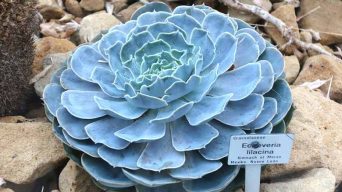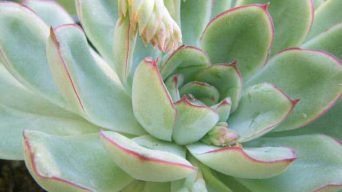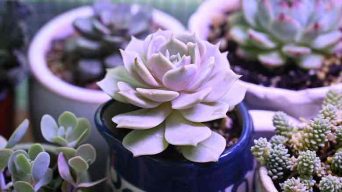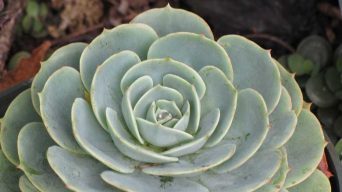Growing Echeveria succulents is a rewarding and low-maintenance activity.
If you are new to succulent plants, the Echeveria derenbergii, the Painted Lady succulent, is a good choice for your first, as it is known to be one of the easiest succulents to care for.
Echeveria derenbergii is a beautiful succulent excellent for succulent and cactus lovers.
Caring for this plant is easy if the basic instructions are kept in mind.
This article provides all the care and propagation information you need about your Painted Lady succulent plant.
Overview
| Family: | Crassulaceae |
| Genus: | Echeveria |
| Botanical Name: | Echeveria derenbergii |
| Common Names: | Painted lady |
| Origin: | Mexico |
| USDA Hardiness Zones: | 9- 12 |
| Size: | 4 inches tall (10 cm) and spreads up to 38 inches (90 cm) |
| Sun Exposure: | Full sun to partial shade |
| Water Needs: | Water thoroughly but infrequently |
| Soil Type: | Well-draining soil |
| Temperature: | 60 to 75˚F (16-24˚C) during the day and 40-60˚F (5-10˚C) at night |
| Humidity Levels: | 40-50% |
Echeveria derenbergii, commonly known as the Painted Lady, is a flowering plant of the family Crassulaceae endemic to Mexico.
The Painted Lady is an evergreen perennial succulent that forms small, dense rosettes of fleshy, blue-gray leaves with red margins.
Rosettes grow up to 3 inches (7.5 cm) in diameter and spread rapidly, creating a thick carpet of rosettes.
The rosettes produce pink stems with yellow, cup-shaped flowers and red tips from late winter to early summer.
Echeveria derenbergii is commonly grown as an ornamental plant in rock gardens and indoor pots.
How To Care for Echeveria Derenbergii ‘Painted Lady’
Taking care of Echeveria derenbergii is a straightforward task, which makes it an ideal plant choice for those new to succulent care.
You’ll find all you need to know about caring for Echeveria derenbergii ‘Painted Lady’.
Sun Exposure & Light Requirements
Echeveria derenbergii plants grow and thrive in full sun to partial shade.
They are ideal houseplants and can grow indoors.
Ideal windowsill placement is near a west or east-facing window where the plants will get bright, indirect sunlight during the day.
In the summer, you can place the plants outdoors in a bright, partially shaded area.
Full sun exposure can burn your Echeveria derenbergii ‘Painted Lady’, so keep them out of direct sunlight during the hottest parts of the day.
Watering Requirements
Like most other low-growing, rosette-shaped succulents, the Echeveria derenbergii ‘Painted Lady’ succulent plant requires minimal watering needs.
Watering once weekly or so in spring and summer is generally enough to keep the plant alive. In winter, reduce watering to once per month or so.
Generally, when watering this low-growing rosette succulent, water until the water drains through the bottom of the pot.
The plant should be allowed to dry out between watering; if left in standing water for too long, it will rot and die.
Soil Requirements
Echeveria Derenbergii ‘Painted Lady’ succulents grow best in well-draining soil.
If you are planting your Echeveria in a pot, use porous soil. The soil shouldn’t hold water for over half an hour after you have watered the plant.
A succulent or cactus mix is suitable for this purpose.
You can also use regular potting soil with added perlite and coarse sand. Avoid adding organic matter like peat moss; it only retains the water and rotates your plant.
We recommend placing a drainage layer at the bottom of the pot before filling it with soil mix. This layer should be made up of shards of broken ceramics, gravel, or anything else that allows water to pass through easily.
Temperature and Humidity
The Echeveria Derenbergii ‘Painted Lady’ succulent plant likes temperatures below 70 degrees Fahrenheit, preferably around 60-65 degrees.
It is okay if the plant goes above this temperature for a short time, but be cautious not to let it sit in direct sunlight or next to a heat source for too long.
If the temperature is below 40 degrees Fahrenheit, you should bring your succulent inside or to a warmer area.
Echeveria Derenbergii ‘Painted Lady’ plant prefers dry environments in areas with low humidity.
High humidity (or areas with high rainfall) can cause rot and other diseases. The ideal humidity is around 40%.
Fertilizing
Echeveria Derenbergii ‘Painted Lady’ does not require much fertilizing.
A small dose of an all-purpose slow-release or balanced liquid fertilizer diluted to half-strength should be sufficient for most succulents.
Do not overfertilize Echeveria Derenbergii ‘Painted Lady’ as it can cause the plant to grow leggy, which means tall and thin.
Only fertilize during the growing season, which is during the spring and summer.
Do not fertilize succulents during their dormant period in the autumn or winter, as this may lead to nutrient burn, harming the plant.
Potting and Repotting
Echeveria Derenbergii ‘Painted Lady’ should be repotted every two years. It grows best when it is in a small pot.
Sometimes, you can leave the plant in a pot for a year or two if its roots aren’t growing outside the container. If this is the case, repot it at your convenience.
When repotting your Echeveria, apply a layer of cactus mix soil to the bottom of the container and fill the remainder with regular potting soil.
You should not plant the succulent deeper than it was in its previous container. Just push down gently on the soil around the roots to settle them into place.
After repotting, don’t water for 1-2 weeks. The plant’s roots need to recover from being disturbed.
Pruning
Echeveria derenbergii is a slow-growing succulent that rarely needs pruning.
Pruning is recommended only for old and dead parts.
Dead leaves can be trimmed off, whereas dead leafless stems (branches) must be removed entirely and often pruned away, except for healthy growth points where you want the plant to branch out.
Pruning dead or damaged leaves help to prevent diseases from affecting the rest of your plant.
Pests and Diseases
Echeveria derenbergii ‘Painted Lady’ succulents are not prone to severe diseases.
However, they can be affected by common pests and diseases such as mealybugs, spider mites, and root rot.
Mealybugs
Mealybugs are tiny, sap-sucking insects that affect a large number of plants.
They can be brown, grey, red, or white and look like tiny cotton pieces.
You can control mealybugs by removing them with a cotton swab dipped in alcohol when the infestation is still light.
Spider Mites
Spider Mites are small, eight-legged insects that look like tiny red or green dots on the plant.
You can control them with several predator bugs and spray the plants with water weekly.
Root Rot
Root rot is a disease caused by overwatering and poor drainage. Succulents affected by root rot will exhibit droopy leaves and brown, dead patches on the leaves.
You can prevent root rot by allowing the soil to dry between watering and improving drainage.
If you have root rot, you should repot your plant with a new potting mix and make sure not to overwater it.
How to Care for Echeveria Derenbergii ‘Painted Lady’ in Winter
Echeveria Derenbergii ‘Painted Lady’ can be grown outside in early spring and summer but should be brought indoors to a well-lit room for the winter.
The Painted Lady Echeveria should be placed in a south-facing window, which receives full sun for at least 4 hours per day or partial sun all day long.
The plant must sit away from drafts, heaters, or air conditioners.
You should reduce watering to once every 10-14 days during winter.
The soil should remain dry between watering, and you should make sure not to overwater the plant. Root rot can occur if the soil stays moist for too long.
How To Propagate Echeveria Derenbergii ‘Painted Lady’
The Echeveria derenbergii ‘Painted Lady’ can be easily propagated from leaves, stem cuttings, and offsets.
Leaf Cuttings Propagation
Leaf propagation is the fastest and easiest method of propagating Echeveria derenbergii ‘Painted Lady’.
To propagate a leaf cutting:
- Remove a leaf from the stem by gently bending it until it snaps free.
- Let the leaf dry for a few days or until the cut edges are dry and calloused.
- Lay the leaf on its side (or upside-down) in a well-draining potting medium.
- Keep the leaf lightly moist until new growth emerges.
- Once the new roots are visible, pot in a well-draining mix.
- Cut the leaf into sections that contain roots with at least 3-5 leaf nodes.
Stem Cuttings Propagation
Echeveria Derenbergii ‘Painted Lady’ can also be propagated by cutting off a stem section and planting it in the soil.
To propagate stems:
- Cut a healthy stem from the mother plant.
- Allow the stem to dry for a day or two after cutting it.
- Plant the stem in a cactus mix of sand that is almost dry.
- Keep the soil moist but not waterlogged.
- Place in bright light, but not in the direct afternoon sun.
- Watch for new growth.
Offsets
Echeveria Derenbergii ‘Painted Lady’ will reproduce offsets by sending out little plantlets.
To propagate your Echeveria through offsets:
- Pull off small offset plants that are growing near the mother plant.
- Allow to dry for a day or two after pulling them off the mother plant.
- Plant them in a cactus mix.
- Water sparingly until the little plant is established.
Final Thoughts
Growing succulents can be a rewarding experience because of their beauty and ease to care.
The Echeveria derenbergii ‘Painted Lady’ succulent plant is no exception, being very beautiful and the lowest maintenance type of Echeverias.
If you take proper care, it can provide great joy for many years!







